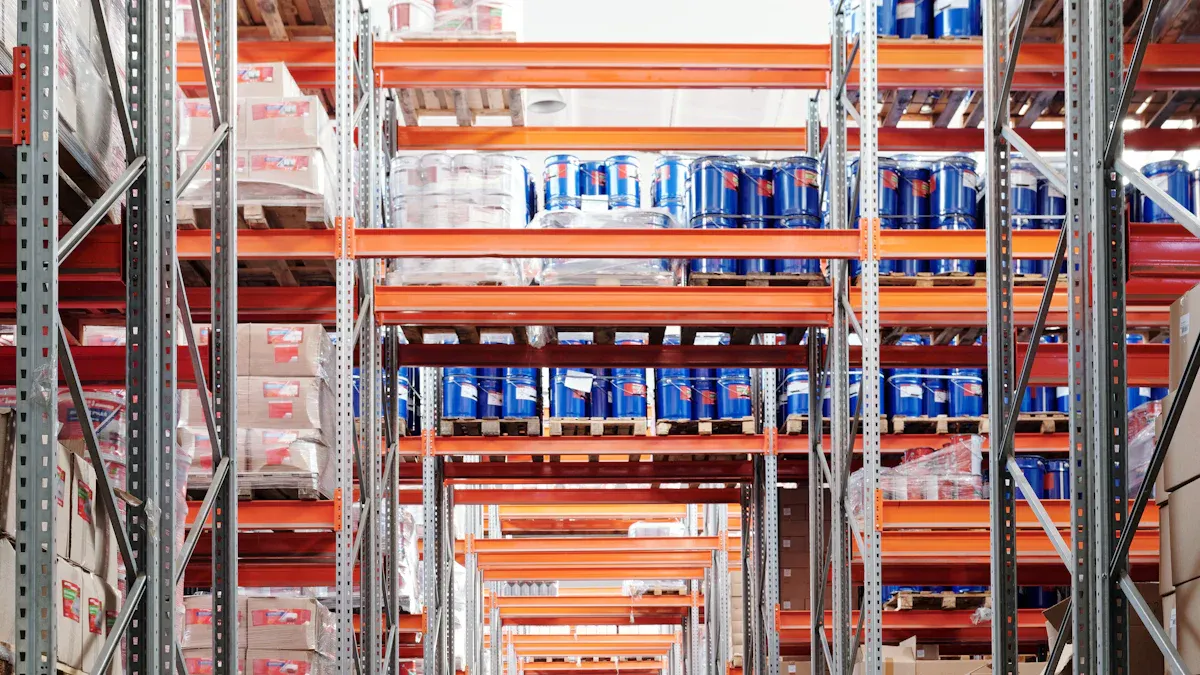
Motion sensor lights play a crucial role in warehouse safety. Their ability to provide automatic lighting improves visibility and minimizes accidents. Smart security lights deter intruders, while energy-saving outdoor sensor lights reduce costs. Businesses often invest in bulk motion sensor lights for commercial buildings to ensure safety and efficiency.
Key Takeaways
- Motion sensor lights make warehouses safer by lighting up quickly. They help prevent accidents in places that are dark.
- These lights use less energy because they turn on only when they sense movement. This helps save a lot of money on power bills.
- Installing and taking care of motion sensor lights keeps them working well. This improves safety and makes warehouse work more efficient.
Understanding Motion Sensor Lights
How Motion Sensor Lights Work
Motion sensor lights operate by detecting movement within a specific range and activating the light source instantly. These systems rely on advanced technologies such as passive infrared (PIR) sensors, ultrasonic sensors, or microwave sensors. PIR sensors detect heat emitted by moving objects, while ultrasonic and microwave sensors use sound waves or electromagnetic waves to identify motion. Once movement is detected, the light turns on, providing immediate illumination. When no motion is present, the system automatically switches off, conserving energy.
The benefits of motion sensor lights extend beyond their functionality. They enhance safety by ensuring visibility in dark or high-traffic areas. Their automatic activation reduces the risk of workplace accidents, especially in warehouses where employees frequently navigate heavy equipment and inventory. Additionally, these lights are energy-efficient, environmentally friendly, and cost-effective, making them an ideal choice for modern warehouse operations.
| Function/Advantage | Description |
|---|---|
| Energy Efficiency | Consumes less energy than traditional fixtures and turns off when no motion is detected. |
| Safety Improvements | Enhances visibility in dark areas, reducing workplace injuries and hazards. |
| Operational Longevity | Lasts about 50,000 hours or more, doubling the lifespan compared to non-motion sensor lights. |
| Automatic Activation | Lights illuminate upon detecting motion, ensuring immediate visibility in high-traffic areas. |
| Environmentally Friendly | Reduces energy waste and has no hazardous effects due to its automatic operation. |
Types of Motion Sensor Lights for Warehouses
Warehouses require different types of motion sensor lights to address various operational needs. Wall-mounted sensors are ideal for entryways and corridors, where they monitor specific areas effectively. Ceiling-mounted sensors, on the other hand, are better suited for larger spaces. They provide a broader detection range, ensuring comprehensive coverage in expansive warehouse environments. Portable sensors offer flexibility, as they can be moved and installed in temporary setups or areas with changing requirements.
Each type of motion sensor light offers unique advantages. Wall-mounted sensors enhance safety in confined spaces, while ceiling-mounted options ensure visibility across wide areas. Portable sensors are particularly useful for warehouses undergoing frequent layout changes. These options allow businesses to customize their lighting solutions based on specific operational demands, ensuring both safety and efficiency.
Safety Benefits of Motion Sensor Lights

Enhancing Visibility in Workspaces
Motion sensor lights significantly improve visibility in warehouse environments. These lights activate instantly when movement is detected, ensuring that workers can see their surroundings clearly. This feature is especially beneficial in areas with limited natural light or during nighttime operations. Proper illumination allows employees to identify potential hazards, such as misplaced tools or uneven surfaces, reducing the likelihood of accidents.
Warehouses often have high shelves and narrow aisles, which can create blind spots. Motion sensor lights eliminate these visibility challenges by providing targeted lighting in specific areas. For example, wall-mounted sensors can illuminate entryways, while ceiling-mounted options cover larger spaces. This adaptability ensures that every corner of the warehouse remains well-lit, enhancing overall safety and operational efficiency.
Preventing Accidents and Injuries
Accidents in warehouses often result from poor lighting conditions. Motion sensor lights address this issue by ensuring consistent and adequate illumination. Workers can navigate their surroundings safely, avoiding common hazards like trips, slips, and falls. Adequate lighting also helps forklift operators and other machinery users to operate equipment more safely, reducing the risk of collisions.
Statistics highlight the importance of motion sensor lights in accident prevention:
- Over 50% of crush deaths in industrial facilities could have been prevented with proper audible and visual alerts, emphasizing the role of motion sensors in safety.
- Proper lighting significantly decreases the occurrence of trips, slips, and falls in warehouse environments.
By reducing these risks, motion sensor lights contribute to a safer workplace, protecting both employees and equipment.
Strengthening Security and Deterring Intruders
Motion sensor lights play a crucial role in enhancing warehouse security. These lights deter unauthorized access by illuminating areas as soon as movement is detected. Intruders are less likely to target well-lit spaces, as the sudden activation of lights can draw attention to their presence. This feature makes motion sensor lights an effective tool for preventing theft and vandalism.
In addition to deterring intruders, motion sensor lights also assist security personnel in monitoring warehouse premises. Bright, automatic lighting ensures that surveillance cameras capture clear footage, even in low-light conditions. This capability enhances the overall security infrastructure of the facility, providing peace of mind to warehouse operators.
Warehouses that invest in motion sensor lights not only improve safety but also protect valuable inventory and equipment. Ninghai County Yufei Plastic Electric Appliance Factory offers high-quality motion sensor lights designed to meet the unique needs of warehouse environments, ensuring both safety and security.
Energy Efficiency and Cost Savings
Reducing Energy Usage with Motion-Activated Lighting
Motion sensor lights offer a practical solution for reducing energy consumption in warehouses. These lights activate only when movement is detected, ensuring that energy is not wasted on illuminating unoccupied areas. This targeted approach to lighting significantly lowers electricity usage compared to traditional lighting systems.
- A warehouse that implemented motion-activated lighting reduced its annual energy consumption by nearly 50%, from 88,784 kWh to 45,501 kWh.
- The project also qualified for approximately $30,000 in incentives and bonuses, showcasing its financial benefits.
- With a total project cost of just $1,779.90, the return on investment was substantial.
By optimizing energy use, motion sensor lights not only cut costs but also contribute to a more sustainable and environmentally friendly operation.
Minimizing Maintenance Costs and Downtime
Upgrading to LED motion sensor lights can drastically reduce maintenance expenses and operational disruptions. These lights have a longer lifespan and require less frequent replacements, minimizing downtime in warehouse operations.
- LED lights with motion sensors can reduce lighting costs by up to 75%.
- Their lifespan extends up to 100,000 hours, significantly outlasting traditional lighting.
- Automated controls eliminate the need for manual intervention, enhancing operational efficiency.
| Evidence Type | Description |
|---|---|
| Energy Savings | Up to 75% reduction in lighting expenses with LED and motion sensors. |
| Maintenance Lifespan | LED lights last 5-10 times longer than traditional lighting. |
| Reduced Downtime | Automated systems minimize manual intervention, reducing operational delays. |
By integrating smart lighting systems, warehouses can also benefit from remote monitoring and diagnostics, further reducing the need for on-site maintenance. Ninghai County Yufei Plastic Electric Appliance Factory provides high-quality motion sensor lights that deliver these advantages, ensuring cost-effective and efficient warehouse operations.
Practical Implementation of Motion Sensor Lights
Installation Guidelines for Warehouses
Proper installation of motion sensor lights ensures optimal performance and safety in warehouse environments. Industry experts recommend the following guidelines for effective integration:
- Motion Sensors: Install these in low-traffic areas such as storage aisles. They activate lights only when movement is detected, reducing energy consumption by up to 30%.
- Dimming Controls: Use dimming controls to adjust light levels based on occupancy and natural light availability. This setup extends the lifespan of LED lights, enhances worker comfort, and prevents unnecessary energy usage.
Warehouse operators should also consider the layout of their facility. Wall-mounted sensors work well in entryways and corridors, while ceiling-mounted sensors provide broader coverage in open spaces. Portable sensors can be deployed in areas with changing layouts. Following these guidelines ensures that motion sensor lights deliver maximum efficiency and safety.
Maintenance Tips for Optimal Performance
Regular maintenance is essential for ensuring the longevity and reliability of motion sensor lights. Common issues and their solutions are outlined below:
| Issue | Causes | Effects | Solution |
|---|---|---|---|
| Sensor Not Detecting Motion Properly | Incorrect placement, obstructions, low sensitivity | Lights fail to activate, reducing convenience | Ensure correct positioning and clear line of sight; adjust sensitivity settings. |
| Lights Stay On Too Long | Improper timer settings, high sensitivity | Unnecessary energy consumption, strain on fixture | Check and adjust timer and sensitivity settings for optimal duration. |
| Lights Turning On and Off Randomly | Environmental triggers, faulty sensor | Inconsistent performance, wear on fixture | Reduce sensor range and adjust placement to avoid triggers. |
| Limited Detection Range or Coverage | Incorrect mounting height, obstructions | Inadequate coverage, missed detection | Install sensor at optimal height and angle per manufacturer guidelines. |
| Sensor or Light Malfunctioning | Power supply issues, loose wiring | Lights fail to function properly | Inspect wiring, secure connections, and replace faulty components. |
| Environmental Factors Affecting Performance | Extreme temperatures, debris on lens | Decreased accuracy, malfunction | Clean sensor regularly and shield from harsh conditions; consider weather-resistant models. |
Routine inspections and cleaning of sensors prevent performance degradation caused by dust or debris. Additionally, consulting the manufacturer’s guidelines for maintenance schedules ensures that the lights operate efficiently over time.
Overcoming Challenges Like False Alarms
False alarms can disrupt warehouse operations and reduce the effectiveness of motion sensor lights. Addressing these challenges requires a combination of strategic placement, sensitivity adjustments, and regular updates.
- Identify Low-Sensitivity Zones: Define areas with frequent harmless movement, such as near ventilation systems, and adjust sensitivity levels accordingly.
- Proper Angling: Position sensors away from reflective surfaces and common traffic areas to minimize false triggers.
- Utilize Natural Covers: Align sensors with natural elements to mitigate environmental influences like sudden lighting changes.
| Strategy | Description |
|---|---|
| Proper Angling | Direct sensors away from high-traffic areas to reduce false alerts. |
| Avoiding Reflective Surfaces | Position sensors to avoid reflections that can trigger false alarms. |
| Utilizing Natural Covers | Use natural elements to shield sensors from environmental changes. |
Regular firmware updates also play a critical role in reducing false alarms. Updated detection algorithms improve the ability of sensors to differentiate between genuine threats and benign movements. Ninghai County Yufei Plastic Electric Appliance Factory offers motion sensor lights with advanced features to address these challenges effectively, ensuring reliable performance in warehouse environments.
Motion sensor lights provide essential benefits for warehouse safety. They enhance visibility, prevent accidents, and strengthen security. Their energy efficiency and cost-saving features make them a practical choice for modern facilities. Ninghai County Yufei Plastic Electric Appliance Factory offers reliable motion sensor lights tailored to meet diverse warehouse needs, ensuring safety and efficiency.
FAQ
What are the key advantages of motion sensor lights in warehouses?
Motion sensor lights improve safety, reduce energy consumption, and enhance security. They provide instant illumination, prevent accidents, and deter unauthorized access effectively.
How do motion sensor lights save energy?
These lights activate only when movement is detected. This targeted lighting approach minimizes energy waste, significantly lowering electricity usage compared to traditional lighting systems.
Tip: For maximum energy efficiency, combine motion sensor lights with LED technology. This pairing ensures longer lifespan and reduced maintenance costs.
Are motion sensor lights suitable for all warehouse layouts?
Yes, motion sensor lights come in various types, such as wall-mounted, ceiling-mounted, and portable options. These designs accommodate diverse warehouse layouts and operational needs.
Post time: May-19-2025
